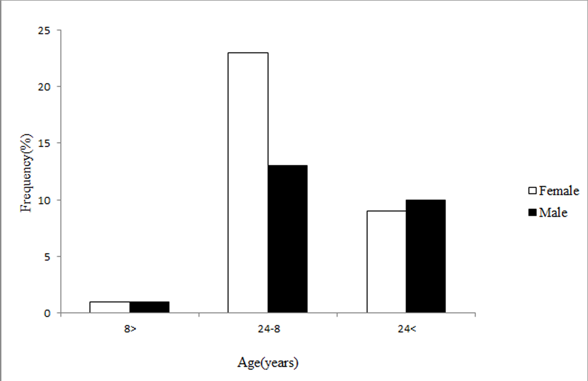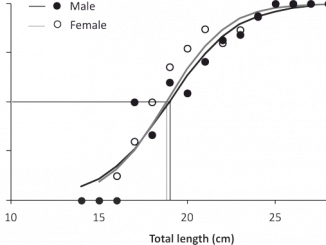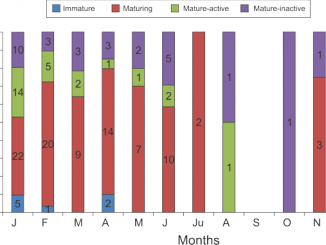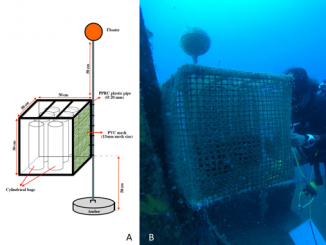
Paper category: Original research paper
Corresponding author: Shima Bakhshalizadeh (shima@phd.guilan.ac.ir)
DOI: 10.2478/oandhs-2021-0027
Received: 21/12/2020
Accepted: 12/02/2021
Full text: here
Citation (APA style): Bakhshalizadeh,S.,Bani,A.,Abdolmalaki,S. & Ponce Palafox,J.(2021).Demographics of great sturgeon (Huso huso) in Iranian waters of the Caspian Sea (2008–2010). Oceanological and Hydrobiological Studies,50(3) 325-332. https://doi.org/10.2478/oandhs-2021-0027
Abstract
Demographic data of the great sturgeon, Huso huso, from the Iranian coastal waters of the Caspian Sea were derived from measurements of individuals with a fork length ranging from 84 to 255 cm, obtained from commercial fisheries. The maximum age of fish caught in the south Caspian Sea was 30 years. The estimates of the asymptotic length L∞ and the growth coefficient (K) were 265.255 cm and 0.062 per year for males and 275.78 cm and 0.08 per year for females, respectively. Total mortality rates obtained by Gulland’s method were larger for males (0.64) than for females (0.46). Annual mortality rates were calculated as 47% for males and 37% for females. Data obtained in this study and their comparison with data from previous studies indicate that the great sturgeon stock is definitely exploited in an unsustainable manner.
Conclusions
The age range of the fish caught was 5 to 30 years, with the highest proportion of age classes being 17 to 25 years – 70% and 83% for females and males, respectively. The annual mortality rates were calculated at 47% for males and 37% for females. The data obtained in this study and their comparison with previous studies indicate that the great sturgeon stock is exploited in an unsustainable manner. Overfishing and several environmental disturbances, such as pollution and modification of hydrological conditions, may have led to the severe depletion of the great sturgeon stock.
Acknowledgements
The authors thank R. Nahrevar, R. Rastin, H. Dadari, A. Alinejad, M. Ataee, A. Qavidel, F. Shakori, A. Kor and G. Salehi for their technical assistance. Sampling authorization was given by the Madar Khaviari sector of the Iranian fisheries organization. We greatly appreciate the constructive comments and suggestions provided by G. Cailliet.
References
Babushkin, N.Y.A. & Borzenko, M.P. (1952). Sturgeon of the Caspian. Pishchepromizdat Moscow: 5–67. (In Russian).
Bakhshalizadeh, S., Zykov, L.A., Nasibulina, B.M., Kurochkina, T.F. & Fazio, F. (2020). Influence of growth on the biological and commercial productivity of Caspian great sturgeon Huso huso. Aquaculture 736139. DOI: 10.1016/j.aquaculture.2020.736139.
Bakhshalizadeh, S., Bani, A., Abdolmalaki, S., Nahrevar, R. & Rastin, R. (2011). Age, growth and mortality of the Persian Sturgeon, Acipenser persicus, in the Iranian waters of the Caspian Sea. Caspian Journal of Environmental Sciences 9(2): 159–167.
Beamish, R.J. & Fournier, D.A. (1981). A method for comparing the precision of a set of age determinations. Canadian Journal of Fisheries and Aquatic Sciences 38: 982–983. DOI: 10.1139/f81-132.
Boscari, E., Vitulo, N., Ludwig, A., Caruso, C., Mugue, N.S. et al. (2017). Fast genetic identification of the Beluga sturgeon and its sought-after caviar to stem illegal trade. Food Control 75: 145–152. DOI: 10.1016/j.foodcont.2016.11.039.
Brennan, J.S. & Cailliet, G.M. (1989). Comparative age-determination techniques for white sturgeon in California. Transactions of the American Fisheries Society 118: 296–310. DOI: 10.1577/1548-8659(1989)1182.3.CO;2.
Bruch, R.M. & Binkowski, F.P. (2002). Spawning behavior of lake sturgeon (Acipenser fulvescens). Journal of Applied Ichthyology 18(4–6): 570–579. DOI: 10.1046/j.1439-0426.2002.00421.x.
Campana, S.E. (2001). Accuracy, precision and quality control in age determination, including a review of the use and abuse of age validation methods. Journal of Fish Biology 59: 197–242. DOI: 10.1111/j.1095-8649.2001.tb00127.x.
Chang, W.Y.B. (1982). A statistical method for evaluating the reproducibility of age determination. Canadian Journal of Fisheries and Aquatic Sciences 39: 1208–1210. DOI: 10.1139/f82-158.
Craig, J.M., Thomas, M.V. & Nichols, S.J. (2005). Length–weight relationship and a relative condition factor equation for lake sturgeon (Acipenser fulvescens) from the St Clair River system (Michigan, USA). Journal of Applied Ichthyology 21: 81–85. DOI: 10.1111/j.1439-0426.2004.00635.x.
Cyr, E.C. (1991). Aspect of the life history of the tarpon, Megalops atlanticus, from South Unpublished doctoral dissertation. University South Carolina, Columbia, SC, USA.
Dudu, A., Georgescu, S.E. & Costache, M. (2014). Molecular analysis of phylogeographic subspecies in three Ponto-Caspian sturgeon species. Genetics and Molecular Biology 37(3): 587–597. DOI: 10.1590/S1415-47572014000400016.
Dunlop, E.S., Shuter, B.J. & Ridgway, M.S. (2005). Isolating the influence of growth rate on maturation patterns in the small mouth bass (Micropterus dolomieu). Canadian Journal of Fisheries and Aquatic Sciences 62: 844–853. DOI: 10.1139/F05-045.
Favro, L.D., Kuo, P.K. & Mcdonald, J.F. (1979). Population-genetic study of the effects of selective fishing on the growth rate of trout. Journal of the Fisheries Research Board of Canada 36: 552–561. DOI: 10.1139/f79-079.
Fazli, H., Tavakoli, M., Khoshghalb, M.R.B. & Moghim, M. (2020). Biological parameters and fisheries indices of beluga sturgeon Huso huso in the southern Caspian Sea. Croatian Journal of Fisheries 78: 1–10. DOI: 10.2478/cjf-2020-0001.
Froese, R. & Pauly, D. (2019). FishBase. World Wide Web electronic publication. Retrieved November 20, 2020, from http://www.fishbase.org/Summary/SpeciesSummary.php?ID=2067&AT=Beluga.
Ghadirnejad, H., Aghilinejad, M., Laloei, F., Asalollahi, M., Shabani, A. et al. (2010). Global population structure of the great sturgeon (Huso huso) in the southern part of the Caspian Sea with emphasis on the Golestan Province. Iranian Fisheries Science Research Institute, Tehran, Iran.
Glass, W.R., Corkum, L.D. & Mandrak, N.E. (2011). Pectoral fin ray aging: an evaluation of a non-lethal method for aging gars and its application to a population of the threatened Spotted Gar. Environmental Biology of Fishes 90: 235–242. DOI: 10.1007/s10641-010-9735-5.
Graham, L.J. & Murphy, B.R. (2007). The Decline of the Beluga Sturgeon: A Case Study about Fisheries Management. Journal of Natural Resources and Life Sciences Education 36: 66–75. DOI: 10.2134/jnrlse2007.36166x.
Gulland, J.A. (1983). Fish stock assessment: a manual of basic methods. FAO (United Nations Food and Agriculture Organization) New York: Wiley.
Holčík, J. (1989). The freshwater fishes of Europe, Volume 1, Part 2: General introduction to fishes: Acipenseriformes. AULA Verlag Wiesbaden, Germany.
Karayev, R.A. (2006). Modelling Caspian sturgeon population dynamics: a new paradigm and new technology. ICES Journal of Marine Science 63: 980–994. DOI: 10.1016/j.icesjms.2006.03.015.
Kazemi, R., Yousefi Jourdehi, A., Pourdehghani, M., Dejhandian, S., Hallajian, A. et al. (2014). Classification of sex and maturity stages of farmed great sturgeon (Huso huso) using blood plasma steroid hormone and calcium ion levels. Iranian Journal of Fisheries Sciences 13(3): 597–607.
Kosarev, A.N. & Yablonskaya, E.A. (1994). The Caspian Sea. The Hague: SPB Academic Publishing.
King, M. (2013). Fisheries biology, assessment and management. John Wiley & Sons, Australia.
Law, R. & Rowell, C.A. (1993). Cohort-structured populations, selection responses, & exploitation of the North Sea cod. In T.K. Stokes, J.M. McGlade & R. Law (Eds.), The Exploitation of Evolving Resources (pp. 73–155). Springer-Verlag: Berlin.
Mirrasooli, E., Ghorbani, R., Gorgin, S., Aghilinejhad, S.M. & Jalali, A. (2019). Factors associated with illegal fishing and fisher attitudes toward sturgeon conservation in the southern Caspian Sea. Mar Policy 100: 107–115. DOI: 10.1016/j.marpol.2018.11.028.
Morison, A.K., Robertson, S.G. & Smith, D.C. (1998). An integrated system for production fish aging: image analysis and quality assurance. North American Journal of Fisheries Management 18: 587–598. DOI: 10.1577/1548-8675(1998)0182.0.CO;2.
Olsen, E.M., Lilly, G.R., Heino, M., Morgan, M.J., Brattey, J. et al. (2005). Assessing changes in age & size at maturation in collapsing populations of Atlantic cod (Gadus morhua). Canadian Journal of Fisheries and Aquatic Sciences 62: 811–23. DOI: 10.1139/f05-065.
Onara, D., Holostenco, D., Paraschiv, M. & Suciu, R. (2014). Preliminary genetic variability of Lower Danube River young of the year (YOY) beluga sturgeon Huso huso (Linnaeus, 1758) using mtDNA markers. Journal of Applied Ichthyology 30: 1286–1289. DOI: 10.1111/jai.12596.
Pirogoviskiy, M.I. & Fadeyeva, T.A. (1982). The size-age composition of the Stellate Sturgeon, Acipenser stellatus, during the marine period of life. Vopr Ichthyology 5: 54–63.
Pourkazemi, M. (2006). Caspian Sea sturgeon Conservation and Fiseries: Past present and Future. Journal of Applied Ichthyology 22: 12–16. DOI: 10.1111/j.1439-0426.2007.00923.x.
Ricker, W.E. (1975). Computation and interpretation of biological statistics of fish population. Bulletin of the Fisheries Research Board of Canada 191: 1–382.
Rien, T.A. & Beamesderfer, R.C. (1994). Accuracy and precision of white sturgeon age estimates from pectoral fin rays. Transactions of the American Fisheries Society 123: 255–265. DOI: 10.1577/1548-8659(1994)1232.3.CO;2.
Rijnsdorp, A.D. (1989). Maturation of male & female North Sea plaice (Pleuronectes platessa L). ICES Journal of Marine Science 46: 35–51. DOI: 10.1093/icesjms/46.1.35.
Roff, D.A. (1984). The evolution of life histories parameters in teleosts. Canadian Journal of Fisheries and Aquatic Sciences 41: 989–1000. DOI: 10.1139/f84-114.
Rosten, C.M., Onara, D., Hawley, K. & Suciu, R. (2012). The status of Danube beluga sturgeon (Huso huso): Past, present and future. VANN 47(4): 523–534.
Ruban, G., Khodorevskaya, R. & Shatunovskii, M. (2019). Factors influencing the natural reproduction decline in the beluga (Huso huso, Linnaeus, 1758), Russian sturgeon (Acipenser gueldenstaedtii, Brandt & Ratzeburg, 1833), and stellate sturgeon (A. stellatus, Pallas, 1771) of the Volga–Caspian basin: A review. Journal of Applied Ichthyology 35: 387–395. DOI: 10.1111/jai.13885.
Ruban, G.I. & Khodorevskaya, R.P. (2011). Caspian Sea sturgeon fishery: a historic overview. Journal of Applied Ichthyology 27: 199–208. DOI: 10.1111/j.1439-0426.2011.01725.x.
Saborowski, R. & Buchholz, F. (1996). Annual changes in the nutritive state of North Sea. Journal of Fish Biology 49: 173–194. DOI: 10.1111/j.1095-8649.1996.tb00015.x.
Saila, G.B., Recksiek, C.W. & Prager, M.H. (1988). Basic fishery science programs. A compendium of microcomputer programs and manual of operation. Developments in Aquaculture and Fisheries Science 18: 1–203.
Sainsbury, K.J. (1980). Effect of individual variability on the von Bertalanffy growth equation. Canadian Journal of Fisheries and Aquatic Sciences 37: 241–247. DOI: 10.1139/f80-031.
Sandu, C., Reinartz, R. & Bloesch, J. (Eds.). (2013). “Sturgeon 2020”: A program for the protection and rehabilitation of Danube sturgeons. Danube Sturgeon Task Force (DSTF) & EU Strategy for the Danube River (EUSDR) Priority Area (PA) 6 – Biodiversity. Bucharest, Romania.
Scarnecchia, D.L., Ryckman, L.F., Lim, Y., Schmitz, B.J. & Firehammer, J.A. (2007). Life history and the costs of reproduction in Northern Great Plains Paddlefish (Polyodon spathula) as a potential framework for other Acipenseriform fishes. Reviews in Fisheries Science & Aquaculture 15(3): 211–263. DOI: 10.1080/10641260701486981.
Stamps, J.A. (1993). Sexual size dimorphism in species with asymptotic growth after maturity. Biological Journal of the Linnean Society 50: 123–145. DOI: 10.1111/j.1095-8312.1993.tb00921.x.
Ta’ati, R., Soltani, M., Bahmani, M. & Zamini, A. (2011). Growth performance, carcass composition, and immunophysiological indices in juvenile great sturgeon (Huso huso) fed on commercial prebiotic. Iranian Journal of Fisheries Sciences 10(2): 324–335.
Taghavi-Motlagh, S.A. (2001). An estimation of growth parameters, mortality rates and yield-per-recruit for Beluga (Huso huso) living in Caspian Sea. Iranian Journal of Fisheries Sciences 3: 25–48.
Tavakoli, M. & Khoshghalb, M.R.B. (2018). Investigation on catch trend and caviar of (Huso huso Brandt, 1865) in the Iranian waters of the Caspian Sea during 2005-2015. Journal of Wetland Ecobiology 37: 5–12.
Ustaoğlu, S. & Okumuş, I. (2004). The Sturgeons: Fragile species need conservation. Turkish Journal of Fisheries and Aquatic Sciences 4: 49–57.
Williot, P., Sabeau, L., Gessner, J., Arlati, G., Bronzi, P. et al. (2001). Sturgeon farming in Western Europe: recent developments and perspectives. Aquatic Living Resources 14: 367–374.
World Conservation Monitoring Centre (WCMC). (2010). Review of four sturgeon species from the Caspian Sea basin. Retrieved December 21, 2020, from http://ec.europa.eu/environment/cites/pdf/reports/caspian_sea_sturgeon.pdf



